Catholic Customs
 |
 |
 |
 |
 |
 |
 |
The Special Blessings on the Feast
of the Assumption
The Feast of the Assumption on August 15 takes place at the highest point of Summer when all the crops and fruit trees are filled with the fruits of the season. How fitting that God should institute this feast honoring Our Lady's height of glory at nature's pinnacle of grandeur when the Summer harvest is ripe and ready to be picked.
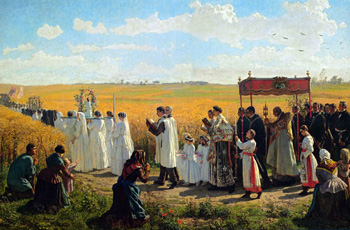 Because of this, it was a custom for the countryside to be blessed on this day. Priests would process through mountains, meadows, fields, orchards, farmland and home gardens giving a benediction to all of nature as they passed. In fishing villages, the seas, oceans and rivers were also blessed to ask Our Lady for a successful fishing season.
Because of this, it was a custom for the countryside to be blessed on this day. Priests would process through mountains, meadows, fields, orchards, farmland and home gardens giving a benediction to all of nature as they passed. In fishing villages, the seas, oceans and rivers were also blessed to ask Our Lady for a successful fishing season.
In the Catholic Eastern Rites, the Feast is one of the Twelve Major Feasts of the year and is preceded by a 14 day fast following the Lenten regulations beginning on August 1. In Italy a similar preparation is made for the feast. The Sicilians have the custom to abstain either partially or entirely from fruit from August 1 until August 15, when a large assortment of blessed fruits along with cheeses and breads is laid out on the table for the Annunciation Feast.
Indeed, in nearly every Catholic country it was looked down upon to eat the first fruits of the Summer without first having them blessed by a priest. In those Catholic societies, the people understood how to offer their best of everything to Our Lady and to make a fitting preparation for her feast!
One old legend states that, after the Fall of Adam, all the flowers and herbs of the earth lost their beautiful scent. Only after the Assumption of Our Lady, when lilies and roses were found in her tomb, did those flowers regain their beautiful fragrances and the herbs their power to heal. This charming legend shows how everything sweet and good in nature was attributed to Our Lady, who was sweetness and goodness personified.
Our Lady’s herbs & fruits
Although herbs were also collected on other feast days such as Corpus Christi, St. John's Eve and Palm Sunday, the main feast when herbs, flowers and fruits were collected from forest, field and garden was the Assumption. They were brought to the Assumption Day Mass to have them blessed by the priest, before Mass. In Armenia, grapes were brought to be blessed.
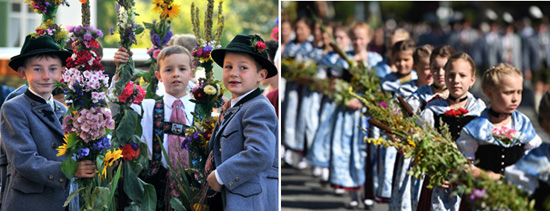 All herbs picked in August and in “Our Lady’s Thirty Days" (August 15 – September 15) were believed to be blessed simply because they were gathered in the days of Our Lady. The Church gave an even stronger blessing to these herbs by elevating them to a
Sacramental with her own rite of blessing, found in the Roman Ritual.
All herbs picked in August and in “Our Lady’s Thirty Days" (August 15 – September 15) were believed to be blessed simply because they were gathered in the days of Our Lady. The Church gave an even stronger blessing to these herbs by elevating them to a
Sacramental with her own rite of blessing, found in the Roman Ritual.
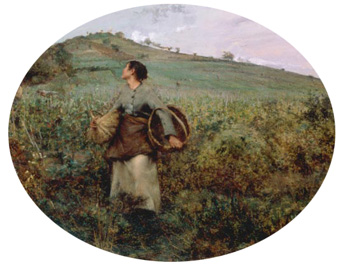 People used to spend days before the Feast of the Assumption collecting special herbs in the woods and meadows, especially those named after Our Lady or associated with her. It was particularly important to choose ones with medicinal properties, which were dried, blessed and kept in the pantry to be used during times of sickness and other ailments.
People used to spend days before the Feast of the Assumption collecting special herbs in the woods and meadows, especially those named after Our Lady or associated with her. It was particularly important to choose ones with medicinal properties, which were dried, blessed and kept in the pantry to be used during times of sickness and other ailments.
The Poles poetically envision the plants expressing their desire to be blessed on Assumption Day: As the women walk through their garden choosing the flowers and herbs to be blessed, the plants call out to them: "Bless me also! I will help as much as I can!"
The sacramental power of the blessed plants
The chosen herbs and flowers were made into neatly arranged bouquets before being brought to the church. In some places, the women would include stalks of various grains (wheat, rye, millet, barley, oats) to have a blessing on the grain as well. Some bouquets were given as gifts to friends, neighbors or the poor.
These blessed herbs were used to obtain blessings and protection throughout the year. Some would be woven into a wreath to hang next to a sacred image or on the family altar. They were also sprinkled into the food of the sick to bring relief for ailments and thrown into the fire during storms to give protection against lightning and fire.
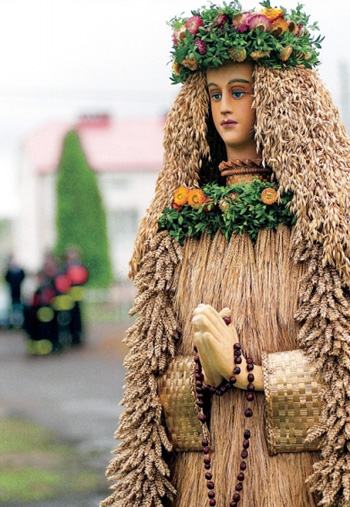 In Belgium, there is a touching ceremony for storms. The father throws a few of the petals of blessed Assumption flowers into the fire as the storm roars about the house, and all present kneel to recite the first lines of St. John's Gospel: "In the beginning was the Word…"
In Belgium, there is a touching ceremony for storms. The father throws a few of the petals of blessed Assumption flowers into the fire as the storm roars about the house, and all present kneel to recite the first lines of St. John's Gospel: "In the beginning was the Word…"
How seriously the Catholics of old considered every aspect of life! They realized the power and goodness of the Author of all Creation and, during the trials of life, had recourse to the blessings that came from Him.
In Germany, the 30 days following the Assumption were a time of rejoicing and giving thanks for the grain harvest and asking for a successful fall harvest and winter planting. Any crops that were harvested during these days were said to be especially nourishing and delicious because of the blessing of Our Lady. Not only was it believed to be superior food, but also to last much longer than food harvested and prepared at other times of year.
These days were thought to be so special that creatures and plants that were normally poisonous lost their poison so that humans would not have to be worried about being attacked by wild beasts or venomous snakes or about becoming ill or dying from eating poisonous plants.
Many pilgrimages to Our Lady's shrines took place all over Europe during these 30 days. A favorite image to venerate in Germany and Poland was Maria im Gerteidekleid (Our Lady in a Dress of Grains) to ask for a good harvest.
Magnificent ceremonies to honor Our Lady
Grand processions and pageants to honor Our Lady took place in nearly every country in Christendom, especially in Central Europe, Italy, France, Spain, and Latin America. Only a few of the most prominent ceremonies will be mentioned here to inspire a return to the marvelous in the liturgical life of Catholic peoples.
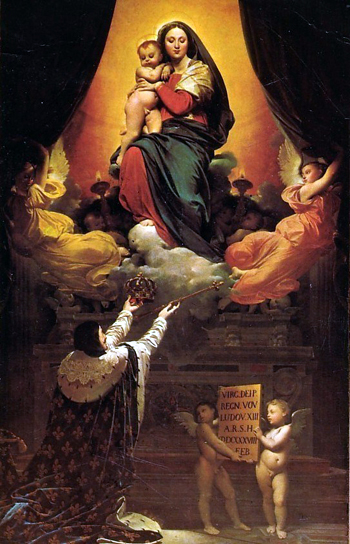 The ceremonies in France were celebrated with particular solemnity, because Our Lady of the Assumption is the patroness of France. King Louis XIII solemnly consecrated France to Our Lady of the Assumption in 1643, declaring that every year on her feast there should be magnificent processions throughout the Kingdom in her honor.
The ceremonies in France were celebrated with particular solemnity, because Our Lady of the Assumption is the patroness of France. King Louis XIII solemnly consecrated France to Our Lady of the Assumption in 1643, declaring that every year on her feast there should be magnificent processions throughout the Kingdom in her honor.
In the Middle Ages, a pageant was performed in many churches by the choir and altar boys, where figures of Angels would descend from the cupola to a sepulcher adorned with flowers before an image of the Blessed Virgin.
Many rural villages surrounding Rome have a "Bowing Procession" in honor of Our Lady. An image of Our Lady is paraded through the town and brought before an image of Our Lord. At their meeting, both are made to bow to each other three times before Our Lord "escorts" Our Lady into the church (symbolizing Heaven) where a solemn benediction is given.
One procession that continues to our days is in Tivoli on the Feast's eve. In this procession, the image used for Our Lord is an ornate triptych dating from the 12th century, depicting Our Lord (Trittico del Salvatore) sitting on His throne and giving a blessing. The painting of Our Lady is Madonna delle Grazie (Our Lady of Grace).
In the Island of Sardinia, the people have a beautiful custom called the "Descent of the Candelieri," which originates from a promise made to Our Lady. In 1580, three plagues were ravaging the island.
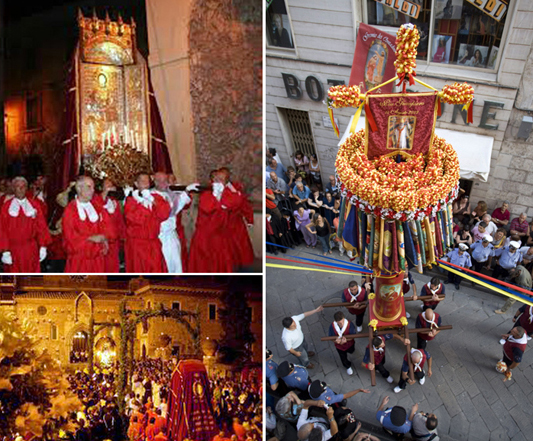 The people made a vow to offer Our Lady seven enormous beeswax candles every year at the feast of her Assumption if she would come to their aid. The plagues all came to a sudden stop on the Feastday, and the people have kept their promise ever since, making the procession of these candles into a joyous occasion with festive drums and a ceremonious dance performed by the men carrying the candles.
The people made a vow to offer Our Lady seven enormous beeswax candles every year at the feast of her Assumption if she would come to their aid. The plagues all came to a sudden stop on the Feastday, and the people have kept their promise ever since, making the procession of these candles into a joyous occasion with festive drums and a ceremonious dance performed by the men carrying the candles.
These men were traditionally chosen from the nine main guilds in the cities of Sardinia. Here is a video showing the elaborately decorated candles being carried by dancing men.
I invite you here to make an analysis, comparing how the ceremonies have declined in pomp and seriousness. This procession in the 1960's has some charm but a bit too much of the 50's optimistic mentality. This procession from the 1990's still has some appeal but lacks the gravitas and formal spirit of the past. A modern day video shows a casual tone and lack of seriousness.
In Elche, Spain, the Spaniards have performed El Misterio de Elche (The Mystery Play of Elche), which reenacts the death and Assumption of Our Lady, since the 13th century. The two day presentation ends with the grand play of the crowning of Our Lady, celebrated with the ringing of bells, the playing of the organ and the burning of fire crackers. Thus do the Spanish people show their great love for Our Lady.
Restoring the feast
To restore the customs of the Church, your parish priest can be asked to perform the solemn blessing of the herbs and fruits before or after the Assumption Day Mass. Every family could then bring fruits and herbs from their gardens arranged in an elegant bouquet to be blessed. These Sacramentals can be used throughout the year to bring blessings to the whole household during times of sickness and of health.
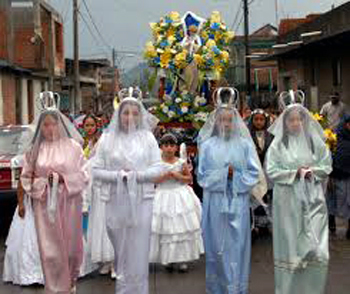 If your priest is not available to do this, the head of the house can read the blessing from the Roman Ritual and sprinkle the herbs and fruit with holy water. Although these objects will not become Sacramentals, they still will have blessings from the holy water and the efficacy of prayer.
If your priest is not available to do this, the head of the house can read the blessing from the Roman Ritual and sprinkle the herbs and fruit with holy water. Although these objects will not become Sacramentals, they still will have blessings from the holy water and the efficacy of prayer.
It is good to use the herbs as the faithful have in the past centuries. To rely on the blessings of the Church in times of natural disaster and sickness, and not just on science and modern inventions, is a way to return to a more organic lifestyle, to have a more supernatural mentality. The ancient customs of the Assumption give us a glimpse of what must be regained.
Another way to honor this great Feast of Our Lady is to have a procession led by the men carrying her image. In the spirit of the grand processions and pageants of the past, everything should be elevated, marvelous and dignified.
A fine meal in the afternoon or evening – including plenty of blessed fresh fruit and herbs – will remind everyone present of the significance of the day.
Let us duly glorify Our Lady on her Feast Day, and, in the words of Dom Guéranger, “Let us too, then, have our hearts on high! Let us today forget our exile to rejoice in Mary’s triumph; and let us learn to follow her by the odor of her sweet perfumes.”
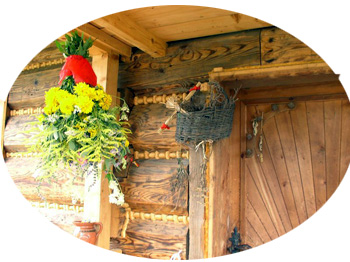

The Blessing of the Wheat Fields by Jules Breton
In the Catholic Eastern Rites, the Feast is one of the Twelve Major Feasts of the year and is preceded by a 14 day fast following the Lenten regulations beginning on August 1. In Italy a similar preparation is made for the feast. The Sicilians have the custom to abstain either partially or entirely from fruit from August 1 until August 15, when a large assortment of blessed fruits along with cheeses and breads is laid out on the table for the Annunciation Feast.
Indeed, in nearly every Catholic country it was looked down upon to eat the first fruits of the Summer without first having them blessed by a priest. In those Catholic societies, the people understood how to offer their best of everything to Our Lady and to make a fitting preparation for her feast!
One old legend states that, after the Fall of Adam, all the flowers and herbs of the earth lost their beautiful scent. Only after the Assumption of Our Lady, when lilies and roses were found in her tomb, did those flowers regain their beautiful fragrances and the herbs their power to heal. This charming legend shows how everything sweet and good in nature was attributed to Our Lady, who was sweetness and goodness personified.
Our Lady’s herbs & fruits
Although herbs were also collected on other feast days such as Corpus Christi, St. John's Eve and Palm Sunday, the main feast when herbs, flowers and fruits were collected from forest, field and garden was the Assumption. They were brought to the Assumption Day Mass to have them blessed by the priest, before Mass. In Armenia, grapes were brought to be blessed.

Boys & Girls in Germany with their Assumption Day bouquets

Herb gathering by Julian Bastien-Lepage
The Poles poetically envision the plants expressing their desire to be blessed on Assumption Day: As the women walk through their garden choosing the flowers and herbs to be blessed, the plants call out to them: "Bless me also! I will help as much as I can!"
The sacramental power of the blessed plants
The chosen herbs and flowers were made into neatly arranged bouquets before being brought to the church. In some places, the women would include stalks of various grains (wheat, rye, millet, barley, oats) to have a blessing on the grain as well. Some bouquets were given as gifts to friends, neighbors or the poor.
These blessed herbs were used to obtain blessings and protection throughout the year. Some would be woven into a wreath to hang next to a sacred image or on the family altar. They were also sprinkled into the food of the sick to bring relief for ailments and thrown into the fire during storms to give protection against lightning and fire.

Honoring Maria im Gerteidekleid (Our Lady in Grains) at a Polish harvest festival
How seriously the Catholics of old considered every aspect of life! They realized the power and goodness of the Author of all Creation and, during the trials of life, had recourse to the blessings that came from Him.
In Germany, the 30 days following the Assumption were a time of rejoicing and giving thanks for the grain harvest and asking for a successful fall harvest and winter planting. Any crops that were harvested during these days were said to be especially nourishing and delicious because of the blessing of Our Lady. Not only was it believed to be superior food, but also to last much longer than food harvested and prepared at other times of year.
These days were thought to be so special that creatures and plants that were normally poisonous lost their poison so that humans would not have to be worried about being attacked by wild beasts or venomous snakes or about becoming ill or dying from eating poisonous plants.
Many pilgrimages to Our Lady's shrines took place all over Europe during these 30 days. A favorite image to venerate in Germany and Poland was Maria im Gerteidekleid (Our Lady in a Dress of Grains) to ask for a good harvest.
Magnificent ceremonies to honor Our Lady
Grand processions and pageants to honor Our Lady took place in nearly every country in Christendom, especially in Central Europe, Italy, France, Spain, and Latin America. Only a few of the most prominent ceremonies will be mentioned here to inspire a return to the marvelous in the liturgical life of Catholic peoples.

King Louis XIII consecrates France to Our Lady of the Assumption
In the Middle Ages, a pageant was performed in many churches by the choir and altar boys, where figures of Angels would descend from the cupola to a sepulcher adorned with flowers before an image of the Blessed Virgin.
Many rural villages surrounding Rome have a "Bowing Procession" in honor of Our Lady. An image of Our Lady is paraded through the town and brought before an image of Our Lord. At their meeting, both are made to bow to each other three times before Our Lord "escorts" Our Lady into the church (symbolizing Heaven) where a solemn benediction is given.
One procession that continues to our days is in Tivoli on the Feast's eve. In this procession, the image used for Our Lord is an ornate triptych dating from the 12th century, depicting Our Lord (Trittico del Salvatore) sitting on His throne and giving a blessing. The painting of Our Lady is Madonna delle Grazie (Our Lady of Grace).
In the Island of Sardinia, the people have a beautiful custom called the "Descent of the Candelieri," which originates from a promise made to Our Lady. In 1580, three plagues were ravaging the island.

Assumption Day processions: left top, The Bowing; bottom left, The Meeting of Our Lord and Our Lady; right, the Candelieri Procession in Sardnia
These men were traditionally chosen from the nine main guilds in the cities of Sardinia. Here is a video showing the elaborately decorated candles being carried by dancing men.
I invite you here to make an analysis, comparing how the ceremonies have declined in pomp and seriousness. This procession in the 1960's has some charm but a bit too much of the 50's optimistic mentality. This procession from the 1990's still has some appeal but lacks the gravitas and formal spirit of the past. A modern day video shows a casual tone and lack of seriousness.
In Elche, Spain, the Spaniards have performed El Misterio de Elche (The Mystery Play of Elche), which reenacts the death and Assumption of Our Lady, since the 13th century. The two day presentation ends with the grand play of the crowning of Our Lady, celebrated with the ringing of bells, the playing of the organ and the burning of fire crackers. Thus do the Spanish people show their great love for Our Lady.
Restoring the feast
To restore the customs of the Church, your parish priest can be asked to perform the solemn blessing of the herbs and fruits before or after the Assumption Day Mass. Every family could then bring fruits and herbs from their gardens arranged in an elegant bouquet to be blessed. These Sacramentals can be used throughout the year to bring blessings to the whole household during times of sickness and of health.

Assumption Day Procession in Michoacan, Mexico
It is good to use the herbs as the faithful have in the past centuries. To rely on the blessings of the Church in times of natural disaster and sickness, and not just on science and modern inventions, is a way to return to a more organic lifestyle, to have a more supernatural mentality. The ancient customs of the Assumption give us a glimpse of what must be regained.
Another way to honor this great Feast of Our Lady is to have a procession led by the men carrying her image. In the spirit of the grand processions and pageants of the past, everything should be elevated, marvelous and dignified.
A fine meal in the afternoon or evening – including plenty of blessed fresh fruit and herbs – will remind everyone present of the significance of the day.
Let us duly glorify Our Lady on her Feast Day, and, in the words of Dom Guéranger, “Let us too, then, have our hearts on high! Let us today forget our exile to rejoice in Mary’s triumph; and let us learn to follow her by the odor of her sweet perfumes.”

A blessed bouquet hung at cottage as protection

Posted August 14, 2020
______________________
______________________
 |
 |
 |
 |
 |
 |


